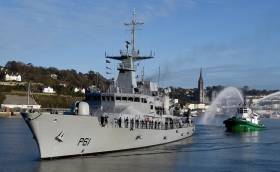Displaying items by tag: New DSG group tug
New Tug to Cork Harbour Welcomes Back Beckett’s Naval Haulbowline Homecoming
#NewTug – A new tug to Cork Harbour was notably seen with a water display to welcome the arrival of LE Samuel Beckett following the crew’s gallant yet harrowing experience in the rescue of migrant refugees in the Mediterranean, writes Jehan Ashmore.
Afloat has identified the tug as Stevns Breaker which has been acquired by Doyle Shipping Group (DSG). The newcomer had been noted in advance of the OPV90 class patrol vessel's Haulbowline homecoming last Friday, having berthed alongside Cork Dockyard also part of the DSG group.
The 70 bollard pull (bp) tug now under the Irish flag joined DSG's Rushbrooke and Cobh based fleet of tugs, worklines-boats in addition their nearby Cross River Ferries operation.
Launched in 2010 as Stevns Breaker the tug would later became part of the Danish tug giant Svitzer which renamed the tug on two occasions as Svitzer Nabi followed by Svitzer Hutton.
The almost 32m long green hulled tug reverted back to her original name to join Irish fleetmate Breedbank of 30 (bp) which sports a red hull. Together the pair assisted the berthing of LE Samuel Beckett at the Naval Base.
Prior to the arrival of the 'Operations Pontus' serving patrol ship, Naval Service flagship LE Eithne vacated the outer Oil Berth to free up this quay for the OPV90 vessel. This led to the LE Eithne shift berths into the confines of the naval basin.
Also berthed in the basin is the laid-up 'Aisling'. Since decomissioning the ship is no longer named with the official LÉ prefix which stands for Long Éireannach/Irish Ship.
A decision has yet to be announced by the Department of Defence as to the future role of the final ‘Emer’ class OPV. There have been calls to have Aisling as a floating museum in Galway Port, given the veteran vessel is twinned with the mid-west single dock basin harbour.























